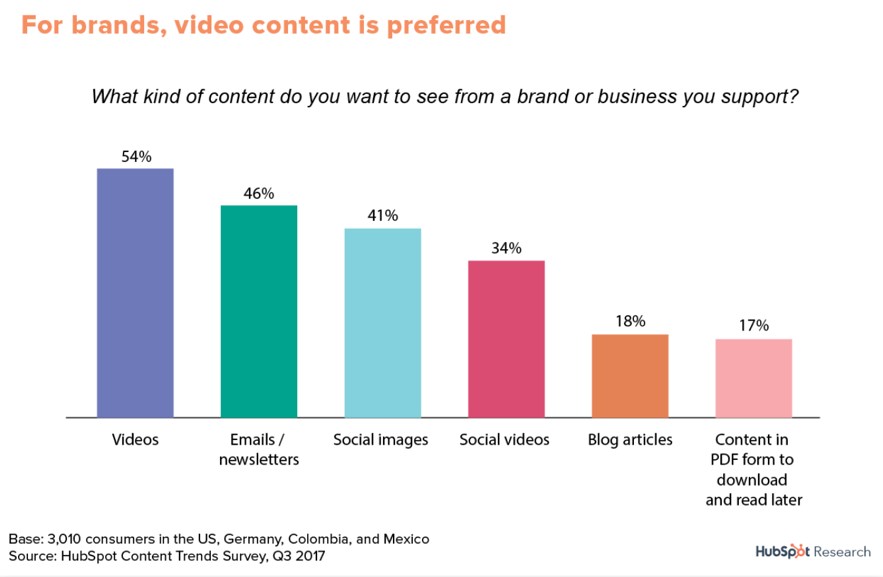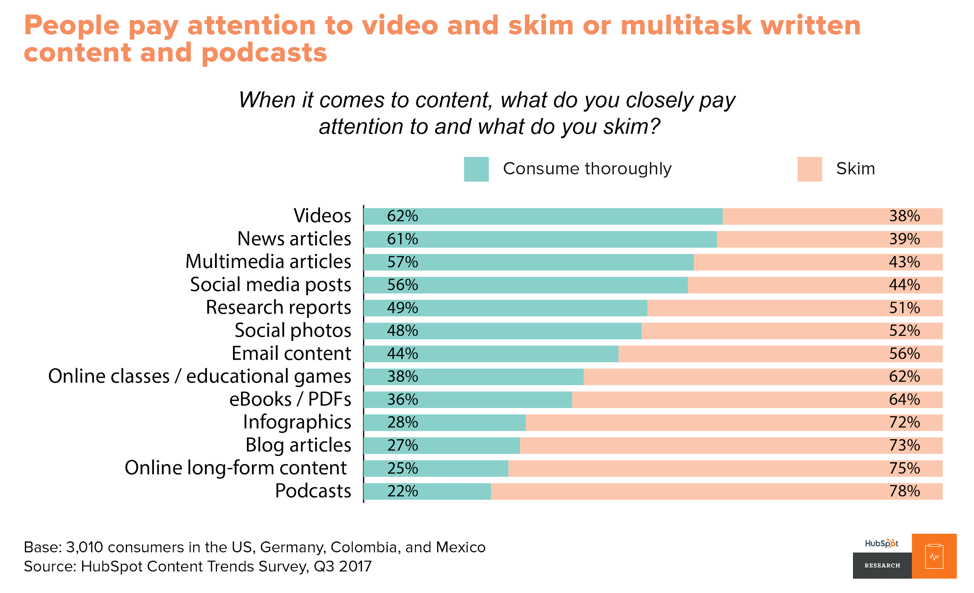Have you had your daily dose of YouTube yet?
Among total engagement, YouTube is the world’s #2 website . “Video” was the 4th most popular search term worldwide in 2019, and 92 percent of internet users (aka four billion people) are watching videos online every month. By 2022, 82 percent of the world’s internet traffic will be video. This is accounting for all video traffic, and with products like verbLIVE these numbers are sure to surge faster.

No surprise: video marketing has grown right alongside. According to the latest numbers from Wyzowl, 86% of businesses use video as a marketing tool. This was 85% in 2020, 87% in 2019, 81% in 2018, 63% in 2017 and 61% in 2016.
But where there’s a boom there’s a bust, right? Wyzowl’s study also found that 90 percent of video marketers feel that competition and noise have decreased in the last year.
So what does this mean?
We here at Verb thought it was time to take a close look at the numbers. We’ve compiled the latest data to answer the questions video marketers need answered: do audiences like video as much as we think they do? Does video look nice, or does it actually convert? And what about return on investment?
Audiences tell us they want video
According to HubSpot’s content trends research, 54 percent of consumers want video, which is more than they want any other form of content from brands.

(Source: Hubspot)
Meanwhile, 68 percent of consumers say they’d prefer to watch a video to learn about a new product. Only 15 percent would prefer to read a piece of text.
Why, exactly, is video so popular with audiences?
Video is simple
It comes down to fatigue. Stress is on the rise, meditation is the fastest-growing health trend according to the CDC, and Marie Kondo has everyone decluttering their closets to declutter their minds.
People spend around 7 hours of their day online, reading information on screens. They’re overwhelmed. This kind of overload makes it tough to make a decision about dinner, let alone choose a new web host or accounting software.
People skim a lot of information, but when it comes to video, they pay attention.

(Source: Hubspot)
Video is compelling
Video offers an easily digestible experience that communicates emotion and information faster than text or static images. Psychologists have found that video—when used to tell an emotional story—releases oxytocin and cortisol in our brains. These bonding chemicals open viewers up to empathy and connection, which can increase trust in the brands that made the videos.
And the sensory benefits go beyond the visual. For instance, ASMR videos are trending with viewers who experience “low-grade euphoria” while listening. Simple videos featuring a whispering voice or sparkly slime can actually decrease stress and sadness. This is meaningful to marketers, who are capitalizing: check out Michelob’s Superbowl commercial, for instance.
Video is shareable
When brands make truly excellent video content, people want to share it. According to a study of Facebook’s top ten brands, video posts are 12 times as likely to be shared as photo and text posts.
In fact, almost half (48 percent) of consumers say they’d share a brand’s video with their friends, over any other type of content. (Only 3 percent said they’d be eager to share a product page, for instance.)
A video is more likely than any other content type to go viral on social media. But just as important: video posts are a steady and significant source of engagement. On Twitter, for example, tweets with video get 10 times the engagement.
And what kind of videos, exactly, do audiences want from brands?
According to Wyzowl, 39 percent of consumers report they want more explainer videos from brands in 2019; 20 percent want more entertaining viral-type videos; 12 percent want more product demos, and 10 percent want video blogs.
Meanwhile, according to Hubspot, worldwide audiences prefer videos that are entertaining, funny, informative, and inspirational, in that order. (Although, Americans, in particular, prioritize humor over entertainment.)

(Source: Hubspot)
Audiences actively appreciate branded video, and research shows that they’re clamoring for more.
But does this translate to actual sales?
Video converts viewers to buyers
According to a study by Aberdeen Group, brands that use video marketing grow their revenue 49 percent faster than brands that don’t.
Simultaneously, 79 percent of people say a branded video convinced them to buy software or an app.
Whether you’re using video as organic content to build your brand’s reputation, or as part of your digital advertising spend, video increases engagement more than any other type of content.
The reason video is so effective at conversion is simple: versatility. With video, marketers can build a sequence of experiences that cover every stage of the sales funnel: top, middle, and bottom. And then they can segment particular videos to different audiences using remarketing.
The results are impressive, no matter your marketing goals: 84 percent of marketers say video has helped them increase web traffic, while 81 percent say video has helped them generate leads.
Interactive video converts more viewers to buyers
Interactive content in particular, according to a study by Demand Metric, is twice as effective at converting customers into buyers. Interactive video encourages viewers to engage in a two-way conversation, sharing relevant information, and building brand loyalty.
If your sales could use that kind of boost, check out how easy it is to make your videos interactive.
Video is cost-effective
Of the businesses who aren’t currently using video marketing, some say that it’s because they’re unclear on video’s ROI (14 percent), while some think they don’t have the money for video (12 percent).
But incorporating video into your marketing strategy doesn’t have to be the budget-breaker you’re imagining. And with the right approach, the results will punch above their weight class.
Budget for a reasonable spend
As with all content marketing, with video you get what you pay for. However, with the surging popularity of live video and disappearing Stories, casual, DIY approaches are increasingly welcome across all channels. Viewers want to be sold on substance, not flash.
And even if you decide to hire professionals to create premium products, there are a ton of ways to keep your budget in line. You can use animation instead of actors, for instance. Or buy license-free music. Or batch-produce a series of related videos at once.
Distribute for a broad impact
Once you’ve produced it, one high-quality video (or series of related videos) can be used and reused across multiple channels.
For instance: including a video in an email newsletter can boost click-through rates 200-300 percent. Meanwhile, 80 percent of marketers say dwell time on their website has increased because of video.
Search engines prioritize video. They view it as high-quality content, which means including it on your website can boost your page ranking. And when it comes to social media, almost every newsfeed algorithm, from Facebook to LinkedIn, rewards video posts over text or image.
Customizing and adjusting videos so that each can be used on several channels will expand your reach and increase your returns. And it just makes sense: as younger generations threaten to abandon email, marketers need to invest in as many channels as possible to figure out which offers the best ROI for their brand.
Oh, and speaking of ROI.
Video marketing has highly measurable ROI
Half of the respondents in an eMarketer survey of B2B video content marketers said that they felt like their ROI on video was improving. Yet, simultaneously, a quarter of them didn’t know what their ROI was at all.
But more than any other content type, video collects data. And with data, you can measure both successes and mistakes to fine-tune what’s working and what needs improvement. Businesses that use advanced video analytics, in fact, are twice as likely to report that their ROI is improving.
Interactive video has even more measurable ROI
In 2018, only 23 percent of marketers were using interactive video. This makes interactive video one of the least saturated options for video marketing. Even more interesting: a full 83 percent of those marketers found interactive video to be effective.
Interactive video also has the advantage of offering a lot more detail on ROI, digging deeper than general sentiment, and into hard analytics. It allows marketers to see who is watching, how long they watched, and how they interacted.
Measurement is crucial to improving your video marketing strategy. A fast, simple way to dig deeper into your numbers is as easy as adding interactive buttons to your existing videos.
You can learn more about interactive video here.
About the author:
David Butler usually shares some of his monumental moments at Verb, dives into the inspiring process of collaboration that makes up the foundation of the Creative Team, and shares plenty of insight with his frequent blog posts.
